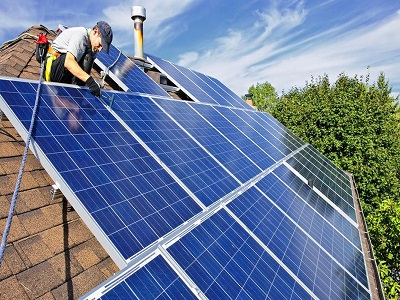
Increasing demand for affordable energy and strict environment regulations are expected to drive the demand of the global solar skin market in the forecast period.
According to TechSci Research report, “Solar Skin Market – Global Industry Size, Share, Trends, Opportunity and Forecast, 2016-2026, Segmented By Type (Photovoltaic Films, Dual Glass, Solar Embedded Windows), By End User (Residential, Commercial, Industrial), By Application (Curb Appeal, Panel Protection, Value Addition) and By Region”, the global solar skin market is expected to grow at a steady CAGR for the forecast period, 2022-2026. The growing demand for renewable energy sources as they can lower the electricity bills and the use of solar energy for energy generation purposes helps in reducing the emission of harmful gases into the environment. Solar skin is the advancement of the solar panel in terms of visual appeal. Solar skin can be used for residential, industrial, or commercial purposes according to the needs of the consumer by offering solar skin in a wide variety of colors, styles, or patterns. Solar energy comprises nanoparticles which are known as quantum dots that pass the electrons and generate electric current when exposed to solar energy. These dots are printed on flexible sheets that can be used as transparent skin to provide power to electronic devices comprising electric vehicles and mobile phones and can be applied to windows or any other surfaces. Solar skin is flexible and lightweight and can work in weaker lighting conditions, for example, cloudy days or indoor lightning, which is expected to bolster the demand for the global solar skin market. The invention of solar skin has opened up numerous opportunities for different applications to be used to power cars, homes, planes, and wearable technology. Homeowners who do not want to put the traditional solar panels due to their aesthetic appearance can choose the solar skin according to the need and convenience of the consumers, which is expected to foster the market demand.
However, lower charging efficiency and initial high investment may restrain the global solar skin market growth for the forecast period.
Browse XX Figures spread through 110 Pages and an in-depth TOC on “Global Solar Skin Market”.
https://www.techsciresearch.com/report/solar-skin-market/7933.html
Global solar skin market is segmented into type, application, end user, regional distribution, and company. Based on the end user, the market is divided into residential, commercial, and industrial. The residential segment is expected to account to hold the major global solar skin market share for the forecast period, 2022-2026. The rise in the number of appliances using electricity as a power source and the growing electricity bills is generating the need for alternate power sources. Solar skin can be used for charging the devices as it flexible and eliminates electricity bills. Market players are making efforts to introduce solar skin with customizable graphics that perfectly match any roof style, color, or pattern. Solar skin acts as external protection to the solar panel, thereby ensuring the higher life of the solar panels.
Based on application, the market is divided into curb appeal, panel protection, and value addition. The curb appeal segment is expected to account for significant market share for the forecast period, 2022-2026. Solar skin can be used as a graphic overlay that can be applied over any traditional solar array to change its visual appearance. Market players are launching the solar skin, which is customizable and can be used to display a wide variety of colors, imagery, text, or any custom artwork according to the client’s needs. Solar skin uses selective filtration technology to display the image and pass the solar energy onto the underlying solar array.
Sistine Solar, Solaria Corporation, Canadian Solar, Trina Solar, Q CELLS, SunPower Corporation, LG Electronics are the leading players operating in global solar skin market. Market players are increasingly focusing on research and development process to fuel higher growth in the market.
Download Sample Report @ https://www.techsciresearch.com/sample-report.aspx?cid=7933
Customers can also request for 10% free customization on this report.
“Market players are providing the customers with interactive applications and websites to give the idea to clients about the final end-use result after the implementation of solar skin onto the solar panels is expected to influence the market demand. Availability of cost-effective solutions based on customer preferences and initiatives taken by the market players to raise awareness about the benefits of using solar technology as an alternate energy source is expected to bolster the global solar skin market growth. Additionally, the adoption of attractive marketing strategies and huge investments for technological advancements is expected to propel the global solar skin market growth till 2026” said Mr. Karan Chechi, Research Director with TechSci Research, a research based global management consulting firm.
“Solar Skin Market – Global Industry Size, Share, Trends, Opportunity and Forecast, 2016-2026, Segmented By Type (Photovoltaic Films, Dual Glass, Solar Embedded Windows), By End User (Residential, Commercial, Industrial), By Application (Curb Appeal, Panel Protection, Value Addition) and By Region” has evaluated the future growth potential of global solar skin market and provided statistics & information on market size, shares, structure and future market growth. The report intends to provide cutting-edge market intelligence and help decision makers take sound investment decisions. Besides, the report also identifies and analyzes the emerging trends along with essential drivers, challenges, and opportunities in the of global solar skin market.
Contact
Mr. Ken Mathews
708 Third Avenue,
Manhattan, NY,
New York – 10017
Tel: +1-646-360-1656
Email: sales@techsciresearch.com
